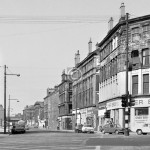I had always been aware that there was a large Orange parade in Glasgow at the beginning of the summer holidays. My Donegal parents, who had originally emigrated to the USA, before settling in Glasgow were always back and forward to Ireland for holidays, weddings and the like. In the summer we were often accompanied by raucous and sometimes rowdy flute bands on the boat back to Glasgow.
The main Orange march had been routed through Gorbals Cross that year, which in itself was unusual; minor walks occasionally passed through the streets but I don’t recall such a major event before or since. The surrounding area was prominently Jewish or Irish Catholics and the event was greeted with neither anger nor joy – just plain indifference. My dad sat in his kitchen armchair unconcerned, puffing his pipe and reading the latest Zane Grey western while my mother pottered around the kitchen preparing dinner. I was intrigued and watched the march leaning from our back room window which overlooked Gorbals Cross. From the  window you could see a good distance due west along Norfolk Street to the low lying bridge that leads to Glasgow Central Railway Station and it was from that dark opening came the vast river of Orange Order marchers. It was odd to see it from such a high vantage point and it was quite clear how the whole thing operated. It was noticeable, for example, that although each Lodge had its own banner, not all of them had their own band. Each Lodge was led off by the Master who carried an open bible with a Crown or some other symbol of royalty on the book. The men, dressed in suits and ties with their orange collarets and their bowler hats, marched in a rather peculiar swaying manner with their feet splayed and their shoulders swinging in rhythm. Behind them came a phalanx of neat and expensively dressed woman all of whom wore large hats and walked in a more demure fashion. After the women came the bands where all the members sported a kind of broadly similar
window you could see a good distance due west along Norfolk Street to the low lying bridge that leads to Glasgow Central Railway Station and it was from that dark opening came the vast river of Orange Order marchers. It was odd to see it from such a high vantage point and it was quite clear how the whole thing operated. It was noticeable, for example, that although each Lodge had its own banner, not all of them had their own band. Each Lodge was led off by the Master who carried an open bible with a Crown or some other symbol of royalty on the book. The men, dressed in suits and ties with their orange collarets and their bowler hats, marched in a rather peculiar swaying manner with their feet splayed and their shoulders swinging in rhythm. Behind them came a phalanx of neat and expensively dressed woman all of whom wore large hats and walked in a more demure fashion. After the women came the bands where all the members sported a kind of broadly similar  semi-military bellboy uniform. Most of them belted out marching tunes, few of which I could identify. About halfway through there was a rather interesting diversion. For a few minutes, due to some traffic hold–up or other, the entire march stopped. Oddly, the marchers kept up their marching beat, without actually marching, a bit like that P.E. exercise you did at school called ‘running on the spot’. One band had finished their piece and waited impatiently directly below me, their marching rhythm disturbed. In a moment of inspiration or simple madness, they decided to play a Rock tune and I tell you this – you have never lived till you’ve heard an Orange flute band attempting to play ‘Heartbreak Hotel’
semi-military bellboy uniform. Most of them belted out marching tunes, few of which I could identify. About halfway through there was a rather interesting diversion. For a few minutes, due to some traffic hold–up or other, the entire march stopped. Oddly, the marchers kept up their marching beat, without actually marching, a bit like that P.E. exercise you did at school called ‘running on the spot’. One band had finished their piece and waited impatiently directly below me, their marching rhythm disturbed. In a moment of inspiration or simple madness, they decided to play a Rock tune and I tell you this – you have never lived till you’ve heard an Orange flute band attempting to play ‘Heartbreak Hotel’
Flanked on each side were the camp followers, exclusively male, wearing flat caps or bunnets; most of them waved small paper Union flags, quite a few wore Ranger’s scarves. Of course this wouldn’t be unusual today but back then football scarves were relatively expensive and not readily available. I could have counted on one hand the amount of scarves that I had seen up until then, yet here they were by the score. I was also mystified by the occasional confident shouts of ‘We are the people’. The whole occasion had the embarrassing air of a boy scout church parade played out by adults.
It was the only time the Orange order passed through the Gorbals and I can only guess that the lack of reaction and sheer indifference of the local population dissuaded the organisers of a repeat performance. It was the only Orange walk I’ve ever witnessed in my life and it was a truly bizarre experience.
oo0oo
